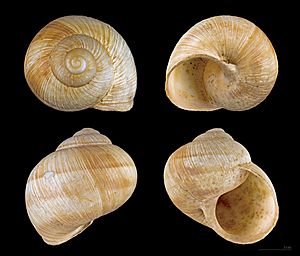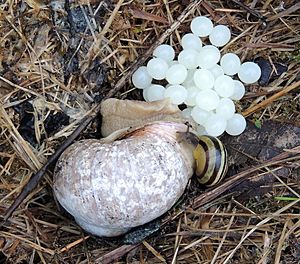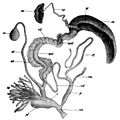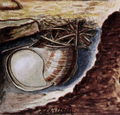Helix pomatia facts for kids
Quick facts for kids Helix pomatia |
|
|---|---|
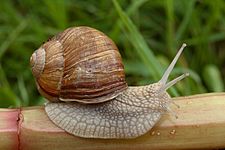 |
|
| Conservation status | |
|
NE
|
|
| Scientific classification | |
| Kingdom: | |
| Phylum: | |
| Class: | |
| Order: |
Pulmonata
|
| Family: | |
| Genus: | |
| Binomial name | |
| Helix pomatia |
|
The Helix pomatia is a very large land snail. It is often called the edible snail, or sometimes the 'Burgundy' or 'Roman' snail. This amazing creature is a type of snail that breathes air and lives on land. It belongs to a group of animals called gastropods, which includes snails and slugs. People in some parts of the world cook and eat these snails as a dish called escargot.
Contents
What Does the Edible Snail Look Like?
The shell of the edible snail is usually a creamy white or light brown color. It might have some faint brown stripes. The shell has about five to six spirals, which are called whorls.
The opening of the shell, called the aperture, is quite large. The edge of this opening is white and curves slightly outwards when the snail is fully grown. The snail's shell is usually between 30 and 50 millimeters wide. It can also be 30 to 45 millimeters tall. That's about the size of a golf ball!
Where Does the Edible Snail Live?
This snail likes to live in places with lots of plants and moisture. In southeastern Europe, you can find Helix pomatia in forests, gardens, and even vineyards. They especially like areas near rivers. These snails prefer places where the soil has a lot of calcium, like limestone.
In central Europe, they live in open forests and bushy areas, also on soil rich in calcium. They enjoy high humidity and cooler temperatures. They need soft soil to dig into when they want to hibernate for the winter or lay their eggs. These snails can live high up in the mountains, sometimes up to 2,100 meters (about 6,900 feet) above sea level!
The Life Cycle of the Edible Snail
Snails don't travel very far. An edible snail usually moves only about 3.5 to 6 meters (11 to 20 feet) in its lifetime.
How Edible Snails Reproduce
Interestingly, these snails are hermaphroditic. This means each snail has both male and female reproductive parts. They still need another snail to mate with. In central Europe, they start to reproduce around the end of May.
- Reproduction
Snails lay their eggs in June and July. Each time, they lay a group of about 40 to 65 eggs. Each egg is quite small, about 5.5 to 6.5 millimeters in size. Baby snails hatch from the eggs after three to four weeks. Sometimes, if the weather is bad, the baby snails might even eat their own siblings to survive!
It takes about two to five years for a snail to become an adult and be able to reproduce. These snails can live for a long time, up to 20 years! It's common to find snails that are 10 years old in nature. The oldest recorded edible snail lived for 35 years!
Hibernation and Estivation
When it gets too cold in winter, or too hot and dry in summer, the snail needs to protect itself. During estivation (summer rest) or hibernation (winter sleep), the snail creates a special lid to seal the opening of its shell. This lid is made of calcium and is called an epiphragm. It helps the snail stay safe and moist inside its shell until conditions are better.
- Hibernation
-
A drawing of H. pomatia during hibernation.
Images for kids
-
Cooked snails, also known as escargots.
See also
 In Spanish: Caracol romano para niños
In Spanish: Caracol romano para niños


